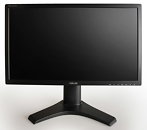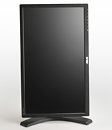Sunday, January 15th 2012

ASUS VA278Q (2560 x 1440) IPS Monitor Gets Detailed
Earlier this week at CES 2012 in Las Vegas, ASUS showcased a brand new monitor designed for professional artists and photographers, a 27-inch model called VA278Q that features an LED backlight, an IPS panel, a native resolution of 2560 x 1440 pixels, and 178/178 degree viewing angles.
ASUS' widescreen also has a 'Smart Contrast Ratio' of 80,000,000:1, DVI, HDMI and DisplayPort connectivity, a stand enabling tilt, pivot, swivel, and height adjustments, and the Splendid Video Intelligence Technology providing six pre-set modes (Theater, Scenery, Gaming, Night View, sRGB, and Standard) that 'optimize colors and image fidelity for the onscreen content'. No word yet about the price tag or availability of the VA278Q.
Source:
Techinstyle.tv
ASUS' widescreen also has a 'Smart Contrast Ratio' of 80,000,000:1, DVI, HDMI and DisplayPort connectivity, a stand enabling tilt, pivot, swivel, and height adjustments, and the Splendid Video Intelligence Technology providing six pre-set modes (Theater, Scenery, Gaming, Night View, sRGB, and Standard) that 'optimize colors and image fidelity for the onscreen content'. No word yet about the price tag or availability of the VA278Q.


23 Comments on ASUS VA278Q (2560 x 1440) IPS Monitor Gets Detailed
This will probably go head to head with the Dell, Samsung and Apple 27" LCDs, landing it in the 700-800€ range.
LED backlighting kills the IPS hence the color accuracy of the monitor, takes a lot more time to calibrate a LED backlit one and the colors are still oversaturated even after careful calibration.
CCFL all the day on an IPS, it gives you back more realistic colors.
The CCFL is much more photorealistic and the colour accuracy is what you'd expect from an in plane switching panel, on the other hand with the LED backlit the colors are unnatural, it's hard to explain but unnatural is the best term that comes to my mind.
If you are going to use it for gaming, browsing etc then you won't see any difference.
Also they are not a cheap investment, I paid my 3008 WFP almost 2k euros back in the day, now I got my U3011 for 1,200 euros each.
RGB LEDs, on the other hand, are a perfect fit for a monitor, since the wavelengths of each red, green and blue LED matches up perfectly to the corresponding colors in the LCD matrix. Most wide-gamut screen use RGBs nowadays, and produce über-natural colors and saturation.
For now all I know is that the one I tried was a big letdown.
After a through google it may be the 30 inch model as well, I don't see a 27 in the old Cinema style.
www.eizo.pl/sites/default/files/ulotki/Raptor_SQ2801.pdf
www.jmsindustrial.nl/bestanden/Air%20Traffic%20Control%20LCD%20monitor.pdf
www.terma.com/multimedia/4628_pbl_hiakari_ARKIV.pdf
Asus may ship this pre-calibrated at the factory. My 238 IPS from them was, and I believe
their 24" 16:10 IPS does also. That was the one I wanted, but was short the additional funds.
With rgbled it should be more in favor of leds?
At this price range there are monitors like : www.bhphotovideo.com/c/product/689882-REG/NEC_PA271W_BK_MultiSync_PA271W_BK_27_Widescreen.html
with:
Adobe RGB: 97.1 (Coverage), 107.2% (Size)
NTSC: 92.6% (Coverage), 102.5% (Size)
sRGB: 100% (Coverage), 144.7% (Size)
Simple sRGB is only 72% NTSC. That is over a 20% difference and is night and day for people who actually need this type of monitor. Likely the difference is slightly less but if you look at the Dell U2711 @ 110% NTSC Typical (don't ask me if that's an inflated # or not) it seems that there is a significant difference...
Even the Dell U2711, which can be found on special in the 6XX $ sometimes, has:
110% NTSC typical , 100% sRGB, 96% Adobe RGB
This makes a world of difference
The only time you will see a 4% difference is with standard TN monitors, hence why LED is starting to become the main backlight in the lower end market